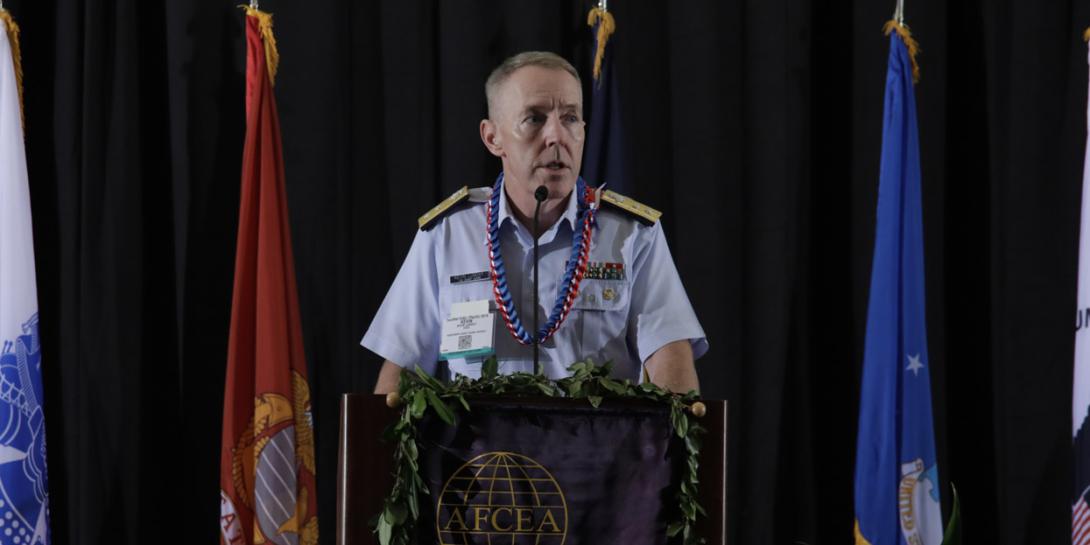Coast Guard Expands Its Indo-Pacific Presence
The U.S. Coast Guard has increased its activities across the Pacific theater, including a national security cutter deployed under the control of the U.S. Navy’s 7th Fleet. Concurrent with these efforts are increased efforts in cyberspace, with a special focus on personnel.
These points were emphasized by Rear Adm. Kevin Lunday, USCG, commander, 14th Coast Guard District, at the keynote breakfast opening day 2 of TechNet Indo-Pacific 2019 being held November 19-21 in Honolulu. Adm. Lunday described an expanding mission that includes serving the maritime security needs of small Pacific nations.
We are leading in protecting maritime critical infrastructure.—Rear Adm. Kevin Lunday, USCG, commander, 14th Coast Guard District @USCGHawaiiPac #AFCEATechNet
— Bob Ackerman (@rkackerman) November 20, 2019
The Coast Guard’s activities on behalf of these nations is not new. The service has 11 ship rider agreements to help other nations secure their exclusive economic zones. Personnel from those nations ride aboard Coast Guard ships in operations against rogue fishing vessels violating international law. And, the Coast Guard is giving decommissioned cutters to other nations such as Vietnam and the Philippines.
Eleven ship rider agreements help other nations secure their exclusive economic zones.—Rear Adm. Kevin Lunday, USCG, commander, 14th Coast Guard District @USCGHawaiiPac #AFCEATechNet
— Bob Ackerman (@rkackerman) November 20, 2019
What has changed is the degree of Coast Guard activity. “The Coast Guard is significantly changing its posture in the Indo-Pacific region,” Adm. Lunday declared. Two new large national security cutters have been based in Hawaii, and one national security cutter has been deployed under the control of the Navy’s 7th fleet.
Even with these new cutters entering service, Adm. Lunday emphasized the importance of personnel over technology. “It matters not what you are, but what you can do, the outcomes you can deliver as part of a team,” he stated. This especially applies to cyber operations, which the admiral described as an essential part of ensuring U.S. national security.
It matters not what you are, but what you can do, the outcomes you can deliver as part of a team.—Rear Adm. Kevin Lunday, USCG, commander, 14th Coast Guard District @USCGHawaiiPac #AFCEATechNet
— Bob Ackerman (@rkackerman) November 20, 2019
“The Coast Guard just gave $100,000 bonuses for cyber experts who re-enlist for another four years,” he announced. “The Coast Guard understands what it takes to keep expertise.”
He added that two trends in cyberspace and technology are driving a lot of what the Coast Guard is doing: convergence and acceleration. Every day, the Coast Guard Cyber Command defends the service’s part of defense cyber networks. While not part of the Defense Department, the Coast Guard is .mil, the admiral noted. He had been dual-hatted when he headed Coast Guard cyber, but that position now is single-hatted and works directly with the U.S. Cyber Command.
Every day, our Coast Guard Cyber Command … defends our part of defense cyber networks—we are .mil.—Rear Adm. Kevin Lunday, USCG, commander, 14th Coast Guard District @USCGHawaiiPac #AFCEATechNet
— Bob Ackerman (@rkackerman) November 20, 2019
The Coast Guard’s civilian cyber personnel fit under the DHS system, while its uniformed personnel operate under the Defense Department. However, the criteria are similar, he pointed out. “It will be our people and our values that will provide the advantage in this strategic competition,” he declared.





Comments